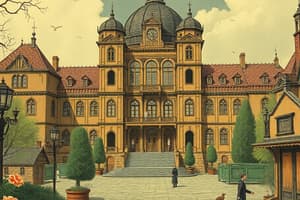Podcast
Questions and Answers
Which countries were part of the Eastern Bloc in 1940?
Which countries were part of the Eastern Bloc in 1940?
- Latvia (correct)
- Lithuania (correct)
- Estonia (correct)
- Finland
What significant event occurred on August 6, 1945?
What significant event occurred on August 6, 1945?
- NATO is formed
- USA drops atomic bomb (correct)
- Germany surrenders
- Berlin Blockade begins
The Truman Doctrine involved sending $400 million to Greece and Turkey.
The Truman Doctrine involved sending $400 million to Greece and Turkey.
True (A)
What was the primary purpose of the Marshall Plan?
What was the primary purpose of the Marshall Plan?
Which of the following was a consequence of the Iron Curtain?
Which of the following was a consequence of the Iron Curtain?
The _____ Pact was formed in 1955.
The _____ Pact was formed in 1955.
What was a key disagreement at the Yalta Conference?
What was a key disagreement at the Yalta Conference?
What was the Red Army's role in Eastern Europe after World War II?
What was the Red Army's role in Eastern Europe after World War II?
The Berlin Blockade lasted for 12 months.
The Berlin Blockade lasted for 12 months.
What was the main goal of the Potsdam Conference?
What was the main goal of the Potsdam Conference?
Flashcards are hidden until you start studying
Study Notes
Timeline Overview
- 1940: Occupation of Lithuania, Estonia, and Latvia.
- 1945:
- Yalta Conference on February 4.
- Germany's surrender in May.
- Potsdam Conference on July 17.
- Atomic bomb dropped on Hiroshima on August 6.
- Axis powers defeated in August.
- 1946: March 5 marked Ivan Curtain speech; Bulgaria integrates into Soviet sphere.
- 1947:
- Truman Doctrine announced on March 12.
- Marshall Plan initiated on June 5.
- Lominform in October.
- Soviet control in Poland limiting Western influence; planned economy imposed.
- 1948:
- Berlin Blockade begins on June 24, ending on May 17, 1949.
- Czechoslovakia and Hungary pressured into Soviet control.
- 1949:
- Soviet Comecon established, limiting trade with the West.
- NATO formed on April 4.
- Formation of the Federal Republic of Germany (FRG) in May; German Democratic Republic established in October.
- USSR successfully tests an atomic bomb in August.
- 1955: Warsaw Pact formed to counter NATO.
Ideologies
- Capitalism:
- Emphasizes private property, profit-making, and free elections.
- Promotes class systems and freedom of the press.
- Communism:
- Advocates for government ownership of property and wealth distribution.
- Enforces single-party rule and aims for a classless society.
- Utilizes propaganda to control information.
Causes and Consequences
- Causes:
- Germany's defeat in WWII.
- Diverging ideologies between capitalism and communism.
- Development and use of the atomic bomb.
- Consequences:
- Increased nuclear proliferation and arms race.
- Emergence of proxy wars representing larger superpowers.
- Establishment of the Iron Curtain and Berlin Wall as Cold War symbols.
Yalta Conference
- Members: Franklin D. Roosevelt, Winston Churchill, Joseph Stalin.
- Agreements:
- Japan to cease hostilities.
- War criminals addressed; focus on Nazi camps.
- Soviet sphere of influence established in Eastern Europe; Germany divided into four occupation zones.
- Formation of the United Nations; elections in liberated countries.
- Disagreements:
- Tensions over Poland's post-war status; Churchill's limited influence due to Red Army presence.
Potsdam Peace Conference
- Members: Harry Truman, Clement Attlee, Joseph Stalin.
- Agreements:
- Berlin partitioned into four zones.
- USSR granted 25% of industrial resources from Germany; Nazi Party banned.
- Disagreements:
- Approaches to Germany's future differed; Stalin’s desire for Eastern European control opposed Truman's “get tough” policy.
Truman Doctrine
- Support for Greece and Turkey: $400 million provided, along with military aid.
- Marked the beginning of a U.S. policy aimed at containing communism, notably due to fears of a domino effect in the region.
Berlin Blockade
- Background: Introduction of Deutschmark led to increased tensions; blockade initiated to limit Western access to West Berlin.
- Impact:
- Blockade cut off all land, rail, and canal connections; Berlin Airlift delivered 2.3 million tons of supplies over one year.
- Reactions:
- Initiated Warsaw Pact as a counter to NATO’s collective defense.
Attributing Blame
- USSR:
- Violated Yalta agreements, initiated Berlin Blockade, expanded communist control.
- USA:
- United Berlin zones to isolate USSR and took unilateral actions contrary to agreements; Marshall Plan seen as a strategy for dominance.
- Context:
- WWII devastated the USSR, leading to heightened security concerns and aggressive foreign policy moves.
Atomic Bomb Implications
- Tensions:
- Truman aimed to showcase power; Soviet fears of U.S. motives fueled conflicts in Eastern Europe.
Stalin's Eastern Europe Strategy
- Motivations:
- Security concerns post-WWII, promotion of communism in unstable economies, resource acquisition, and superpower rivalry with the USA.
- Methods:
- Utilization of military power, establishment of communist governments, and rigging of elections to suppress opposition.
Studying That Suits You
Use AI to generate personalized quizzes and flashcards to suit your learning preferences.




